2016 Georgetown University Press. All rights reserved. No part of this book may be reproduced or utilized in any form or by any means, electronic or mechanical, including photocopying and recording, or by any information storage and retrieval system, without permission in writing from the publisher.
Library of Congress Cataloging-in-Publication Data
Names: Gilman, Hollie Russon, author.
Title: Participatory budgeting and civic tech : the revival of citizen engagement / Hollie Russon Gilman.
Description: Washington, DC : Georgetown University Press, 2016. | Includes bibliographical references.
Identifiers: LCCN 2016007093 (print) | LCCN 2016008596 (ebook) | ISBN 9781626163409 (pb : alk. paper) | ISBN 9781626163416 (eb)
Subjects: LCSH: Local budgetsUnited StatesCitizen participation. | Local financeUnited States.
Classification: LCC HJ9147 .G55 2016 (print) | LCC HJ9147 (ebook) | DDC 352.4/82140973dc23
LC record available at http://lccn.loc.gov/2016007093

This book is printed on acid-free paper meeting the requirements of the American National Standard for Permanence in Paper for Printed Library Materials.
17 16 9 8 7 6 5 4 3 2 First printing
Printed in the United States of America
Preface
ONE EVENING OVER DINNER while I was a doctoral student I was introduced to Joe Moore, a Chicago aldermanthe first elected official to implement participatory budgeting (PB) in the United States. Through PB, the alderman put discretionary Menu Money, about $1.3 million, into the hands of the wards residents. PB is a democratic process to empower citizens to decide on public budget allocations and vote on where and how to implement. Unlike other processes, PB creates a mechanism for binding citizen input in decision making.
Chicagoof all placesseemed an unlikely candidate for democratic innovation in the United States. However, as I listened, I found myself listening to an inspiring story about community members working together, meeting new people, and working in tandem with elected officials. Most of all, people received an interactive and creative form of civic education. This was not a traditional class in civics but rather an opportunity for a hands-on experience in finding out how precisely to turn ideas into policy.
Several years after this dinner conversation, I joined the Obama administration to help execute the second-term open government agenda. Part of my goal in working in the Office of Science and Technology Policy was to think about the opportunities and challenges of leveraging technology and including PB within broader United States commitments under the Open Government Partnership. In 2011 President Barack Obama launched the Open Government Partnership along with Brazil, Indonesia, Mexico, Norway, the Philippines, South Africa, and the United Kingdom. To date, it includes sixty-six nations. Countries in this multilateral partnership commit to greater citizen participation, collaboration, and transparency in governance. Each member country is required to submit a national action plan outlining its domestic open government commitments.
Part of the appeal of PB is precisely its transnational path to prominence. The process began in Porto Alegre, Brazil, in 1989 after a twenty-year military dictatorship and first came to the United States in 2009. PB is a transnational innovation, leveraging insight from the Global South to the United States. Understanding its current manifestations in the United States helps shed light on the growing trend of civic innovation happening in the United States and globally. I argue that PB is one promising democratic experiment within a larger tool kit to reimagine the relationship between citizens and their governance institutions. PB can add to and enhance the existing civic infrastructure and further democratic experimentation. This publication is motivated by the desire to examine the intersection of civic engagement with institutions of governance within the larger movement to capitalize on new technology to improve democracy. This family of innovations has potential to usher in a new type of public sphere where everyday people have more interaction and engagement with their institutions.
This public sphere will involve networked community and in-person deliberation and dialogue. Technology is a necessary part of the equation. I view democracy as an opportunity for self-renewal and human expression in a public sphere. As social reformer John Dewey notes, Life is a self-renewing process through action upon the environment. If democracy is ultimately the sum of its people, each generation faces an opportunity to reimagine the democratic experience. Digital tools can help support the opportunities to reduce barriers to entry, bring new information into the public sphere, and increase the opportunities for people to monitor their government.
However, the precise pathways through which democratic deepening takes place and the use of digital tools require further research. In order to shed light on the emerging phenomena, I combine empirical results with a theoretical and normative framework. I employ a variety of methods, including formal interviews, field observations, site visits, process tracing, difference-in-difference analysis, and electronic sources. I have tried to be clear where my claims rest on personal observations based on my extensive firsthand experience of PB.
Much further research is needed in this emerging space to understand what works and why. This work is but one attempt to begin the conversation, outlining why inclusive governance and innovations are important in the face of rising declines in institutional trust. It provides an introduction to inclusive governance and articulates a framework for understanding civic innovation in the United States. It then provides an in-depth examination of PB and its implementation in New York City. The goal is to illustrate how a given innovation takes root in a highly context-specific environment. I end by providing further examples of civic innovation and policy recommendations geared toward both researchers and practitioners.
This work is influenced by research conducted over several years. For an extended take on these topics, see my full-length book Democracy Reinvented (2016), published in the Harvard Kennedy Schools Innovative Governance in the 21st Century series with Brookings Institution Press. I conducted case study research on three pilots of PB in the United States (Chicago, New York City, and Boston), analyzing each in order to synthesize common recommendations informed by experience working closely with practitioners and as a policymaker.
The work of building the body of quantitative and qualitative research that will support PB and other civic innovations in the United States is just getting started. Rather than offering a complete history of PB or a comprehensive study of any one instance of PB, my goal is to provide a rich and multifaceted analysis of an emerging civic process while also generating a theoretical understanding applicable beyond PB. In New York City, the Community Development Project at the Urban Justice Center led the research and evaluation of the process and worked to organize graduate students, professors, and practitioners in the field of PB to draft surveys to be administered at different phases of the processduring the neighborhood assemblies, budget delegate committees, and at the vote.

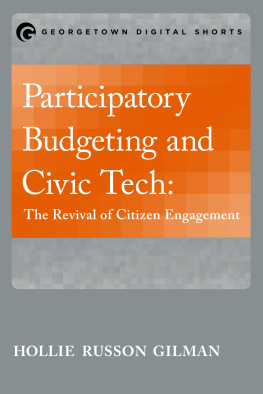


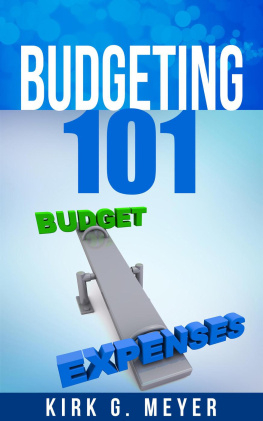
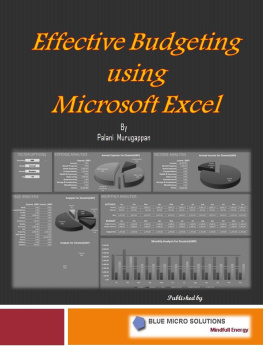
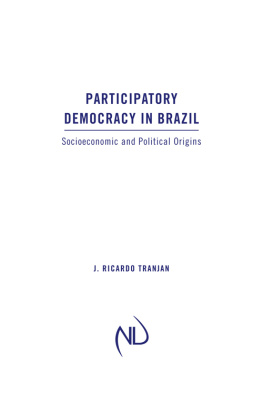
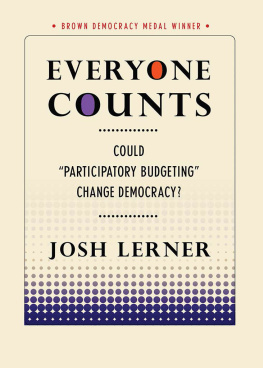
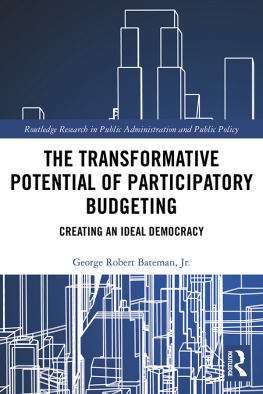
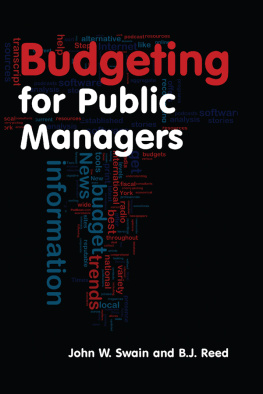
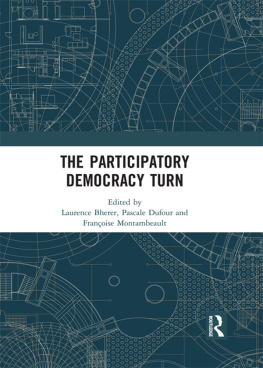
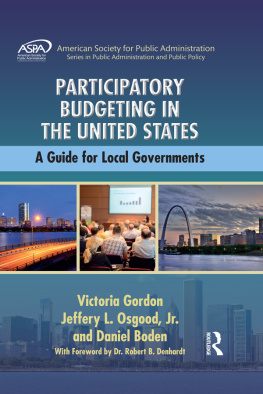
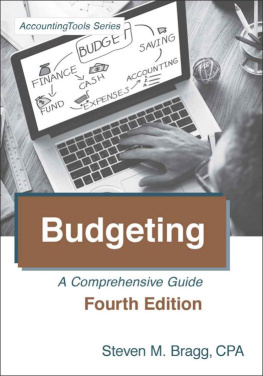
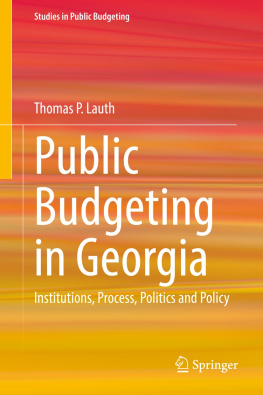

 This book is printed on acid-free paper meeting the requirements of the American National Standard for Permanence in Paper for Printed Library Materials.
This book is printed on acid-free paper meeting the requirements of the American National Standard for Permanence in Paper for Printed Library Materials.